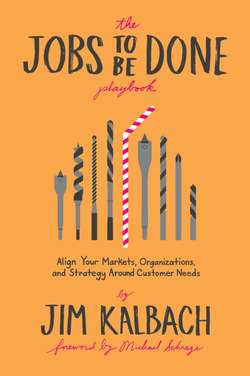Читать книгу The Jobs To Be Done Playbook - Jim Kalbach - Страница 18
На сайте Литреса книга снята с продажи.
Recap
ОглавлениеA job to be done is an objective that someone is trying to achieve in a given context. It’s not about your product, solution, or brand, but what people want to accomplish. Thinking about how customers perceive value shifts your focus from inside-out to outside-in.
Precursors to JTBD go back to Theodore Levitt, who told his students, “People don’t want a quarter-inch drill, they want a quarter-inch hole.” Peter Drucker was the first to use the term “job to be done” in conjunction with what he called a “process need,” or objective that people wanted to accomplish.
Clayton Christensen is universally credited with popularizing the concept of JTBD. But divergent schools of thought have divided the field into two camps. On one side is the Switch technique, which reverse-engineers motivations from a purchase experience. On the other is ODI, a comprehensive technique for determining business opportunity through unmet needs. Contentious debates between proponents of each side cause newcomers to experience confusion and distaste.
Regardless of the point of view, common core principles hold JTBD together as a field:
• People want to get a job done, not to interact with an organization.
• Jobs are stable over time.
• People seek services that help them get more of their job done, better.
• The job predicts behavior and becomes the key unit of analysis.
• JTBD isn’t limited to one discipline; it applies across the organization.
The benefits of JTBD are many: JTBD shows causality, enjoys longevity, reflects a human-centered approach, helps break down silos and shift mindsets, and fits with modern techniques.
JTBD provides a consistent language for understanding people’s motivations to reach an objective. The approach is not a single method or technique, but rather a way of seeing. This book gathers together many of the common approaches that have developed over the last 30 years of JTBD research and practice.
TABLE 1.1 COMPARING DEFINITIONS OF A JOB TO BE DONE
| SOURCE | DEFINITION |
| Clayton Christensen, Taddy Hall, Karen Dillon, and David S. Duncan, Competing Against Luck (New York: HarperBusiness, 2016) | “A job to be done is your customers’ struggle for progress and creating the right solution and attendant set of experiences to ensure you solve your customers’ jobs well.” |
| Bob Moesta, "Bob Moesta on Jobs-to-be-Done," interview by Des Traynor, Inside Intercom (podcast), May 12, 2016 | “A job is really the process of making progress... It’s helping them understand the struggles they have to go through to get to the progress they want... Remember, it’s not Jobs—it’s Jobs-to-Be-Done. It’s about the thing they want to do better, and that’s where innovation has to be.” |
| Anthony Ulwick, “What Is Jobs-to-be-Done?” JTBD+ODI (blog), February 28, 2017 | “The theory is based on the notion that people buy products and services to get a ‘job’ done. A ‘job’ is a statement of what the customer is trying to achieve or accomplish in a given situation.” |
| Sandra M. Bates, The Social Innovation Imperative (New York: McGraw-Hill, 2012) | “Jobs are defined as the goals and objectives that people want to accomplish or what they are trying to prevent or avoid... Jobs are what motivate people to buy a product or service such as an iPhone, which enables them to ‘be productive while on the go,’ or auto insurance so they can protect against financial loss in the case of an accident.’’ |
| Lance Bettencourt, Service Innovation (New York: McGraw-Hill, 2010) | “What the customer values is the ability to get a job done well. The customer job therefore offers a stable, long-term focal point for the improvement of current services or the creation of new-to-the-world services. Ultimately customers are loyal to the job.” |
| Mike Boysen, “What #JobsToBeDone Is, and Is Not,” Medium (blog), December 2017 | “A Job is a goal or objective; or a problem that must be solved in order to create a desired future-state. Yes, it’s progress as we are moving from a current-state to a future-state (in getting the job done). Executing a process or Job is progress. Solving problems is progress. Achieving goals and objectives is progress.” |
| Stephen Wunker, Jessica Wattman, and David Farber, Jobs to Be Done: A Roadmap for Customer-Centered Innovation (New York: AMACON, 2016) | “While jobs are the tasks the customers are looking to get done in their lives, job drivers are the underlying contextual elements that make certain jobs more or less important.” |
| Alan Klement, When Coffee and Kale Compete, 2nd Ed. (Self-published, 2018) | “A Job to Be Done is the process a consumer goes through whenever she evolves herself through buying and using a product. It begins when the customer becomes aware of the possibility to evolve. It continues as long as the desired progress is sought. It ends when the consumer realizes new capabilities and behaves differently, or abandons the idea of evolving.” |
| Des Traynor in Intercom on Jobs-to-be-Done, (Self-published, 2016) | “Jobs-to-be-Done... lets you focus on making things people actually want. When you’re solving needs that already exist, you don’t need to convince people they need your product.” |
